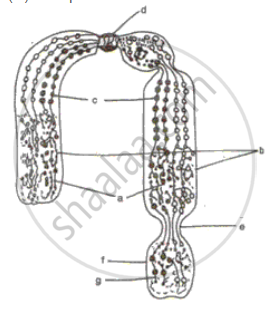Advertisements
Advertisements
प्रश्न
Differentiate between
Chromatin and Chromosome.
उत्तर
| Chromatin | Chromosome | |
| (i) | Uncondensed form of nucleoprotein. | Condensed form of nucleoprotein. |
| (ii) | Seen in interphase stage of cell division. | Seen in M-phase. |
| (iii) | Control of metabolic activities. | Vehicles of heredity. |
APPEARS IN
संबंधित प्रश्न
What is the difference between chromatin fibre and chromosome?
What are genes?
Fill in the blank
The _______ (s) are surrounded by radiating rays called aster
The component which is in the nuclei of cells and carries the hereditary characteristics is called ______.
Label the lettered parts of the given figure and answer the following questions:
(i) What does this diagram represent?
(ii) What is the importance of'd'?
(iii) What are the 'staining' properties of 'b' and 'c'?
(iv) Who gave the term used for this structure today?
(v) What is a?
(vi) Is 'e' present in all chromosomes?

Synthesis phase in the cell cycle is called so for the synthesis of more of
Explain the Term Centrioles
Explain the Term Chromosomes
Mention, if the following statement is True or False. If false rewrite the wrong statement in its correct form:
Chromosomes other than sex-chromosomes are autonomous.
Mention, if the following statement is True or False. If false rewrite the wrong statement in its correct form:
Chromosomes are the thickest and shortest in telophase.
Duplicated chromosomes are joined at a point termed ______.
State the Location: Chromosomes
Name the following:
Pair of genes responsible for a particular characteristic.
With the help of a neat labelled diagram, describe the structure of chromosome.
The region of the chromosome where the spindle fibres get attached during cell division ______
The loss of one or more chromosomes in ploidy is called ______.
Match the following.
| 1. Autosomes | - | Trisomy 21 |
| 2. Diploid condition | - | 9 : 3 : 3 : 1 |
| 3. Allosome | - | 22 pair of chromosome |
| 4. Down’s syndrome | - | 2n |
| 5. Dihybrid ratio | - | 23rd pair of chromosome |
______ is a sudden permanent heritable change that can occur in the gene, in the chromosome or chromosome number.
Generally, the recessive character is expressed only when present in a double recessive condition i.e. homozygous condition. However, a single recessive gene can express itself in human beings when the gene is present on ______
A male gorilla has 48 chromosomes in each of its body cells. How many chromosomes will each of the sperms have?

